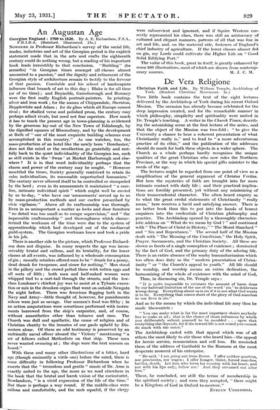An Augustan Age
Georgian England : 1700 to 1820. By A. E. Richardson, F.S.A., F.R.I.B.A. (Batsford. Illustrated. 21s.) NOWHERE in Professor Richardson's survey of the social life, trades, industries, and art of the Georgian period is the explicit statement made that in the arts and crafts the eighteenth century could do nothing wrong, but a reading of his important book leads irresistibly to that conclusion. "Building" (he remarks) "in Georgian times amongst all classes almost amounted to a passion," and the dignity and refinement of the Georgian style of architecture remain to testify to the fervour of that passion. Constable and his school of landscapists influence that branch of art to this day ; Blake is for all time (or of no time) ; and Reynolds, Gainsborough and Romney were the first really English portrait-painters. In printings silver and iron work ; for the names of Chippendale, Sheraton, Hepplewhite and Adam ; for its glass which all Europe cannot rival ; for studied verse and polished prose, the century may perhaps admit rivals, but need not fear superiors. How much it has to teach the present age in town-planning is evidenced by the generous lay-out of the New Town of Edinburgh, by the dignified squares of Bloomsbury, and by the development at Bath of " one of the most exquisite building schemes ever accomplished in this country." As one watches, too, the mass-production of an hotel like the newly born ' Dorchester,' does not the mind or the recollection go gratefully and rest- fully back to the quiet individuality of the Georgian inn, such as still exists in the Swan ' at Market Harborough and else- where ? It is in that word individuality perhaps that the charm and power of the century may be sought. " However unsettled the times, Society generally contrived to retain its calm individualism, its reasonable unperturbed humanism." The century never allowed itself to be controlled or stampeded by the herd ; even in its amusements it maintained " a care- free, intimate individual spirit " which might well be envied by us to-day, " who have our 'amusements' served up to us by mass-production methods and our curfew prescribed by civic vigilance." Above all its craftmanship was thorough. Even in so unimportant a matter as locks and door furniture " no detail was too small as to escape supervision," and " the impeccable craftsmanship " and thoroughness which charac- terized the workman of the time were due to the system of apprenticeship which had developed out of the mediaeval guild-system. The Georgian workman knew and took a pride in his job.
There is another side to the picture, which Professor Richard- son does not disguise. In many respects the age was incon- ceivably brutal and callous, and its brutality, for the lower classes at all events, was inflamed by a wholesale consumption of gin ; rascally retailers offered men to be " drunk for a penny, dead drunk for twopence, and straw for nothing." Men stood in the pillory and the crowd pelted them with rotten eggs and all sorts of filth ; both men and half-naked women were whipped tied to a cart-tail through the streets, and the low- class Londoner's chiefest joy was to assist at a Tyburn execu- tion or mix in the drunken orgies that went on outside Newgate the night before. There was ferocious flogging both in the Navy and Army—little thought of, however, for punishments ashore were just as savage. Our seamen's food was filthy ; irl an action amputations were sometimes performed with instru- ments borrowed from the ship's carpenter, and, of course, without anaesthetics other than tobacco and rum. The Church was dull and apathetic, the cause of religion and of Christian charity to the inmates of our gaols upheld by Dis- senters alone. Of them an odd testimony is preserved by an unfriendly naval officer aboard the ' Victory ' mentioning " a set of fellows called Methodists on that ship. These men never wanted swearing at ; the dogs were the best seamen on board."
With these and many other illustrations of a bitter, hard age (though eminently a virile one) before the mind, there is some difficulty in following Professor Richardson when he asserts that the " tremulous and gentle " music of Dr. Arne is exactly suited to the age, the more as we read elsewhere in the book that the brutal and harsh vision of the caricaturist, Rowlandson, " is a vivid expression of the life of the time." But there is perhaps a way round. If the middle-class were callous and comfortable, and the mob squalid, if the clergy were subservient and ignorant, and if Squire Western cor- rectly represented his class, there was still an aristocracy of cultured and elegant manners, patrons of all that was fine in art and life, and, on the material side, fosterers of England's chief industry of agriculture. If the lower classes almost fed on gin, my Lords could cultivate the Higher Life on " Good Solid Edifying Port."
The value of this book, great in itself, is greatly enhanced by some 260 illustrations, most of which are drawn from contemp-






































 Previous page
Previous page